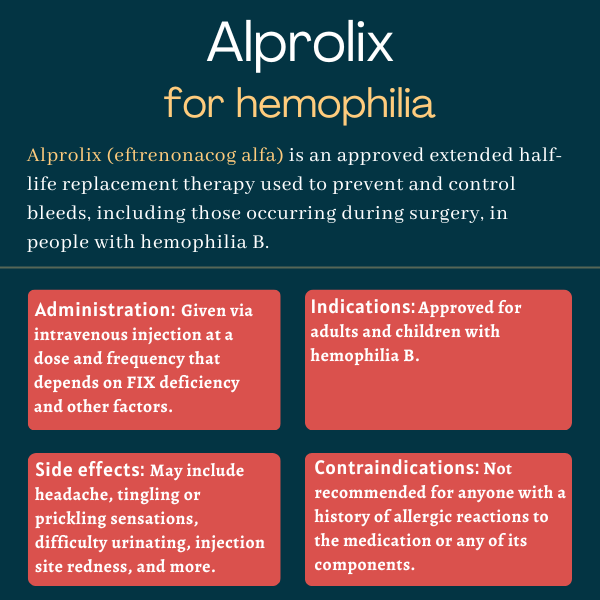Alprolix (eftrenonacog alfa) for hemophilia
What is Alprolix for hemophilia?
Alprolix (eftrenonacog alfa) is an approved therapy that is used to prevent and control bleeds, including those occurring during surgery, in adults and children with hemophilia B.
The therapy is a recombinant, or lab-made, DNA-derived coagulation factor IX concentrate, and is administered via an intravenous, or into-the-vein, injection.
Alprolix was originally developed by Biogen and then by Bioverativ Therapeutics, which was acquired by Sanofi in 2018. Sanofi currently markets Alprolix in the U.S., Canada, Japan, and other regions, while Sobi commercializes it in the European Union, U.K., and other markets.
Therapy snapshot
| Brand name: | Alprolix |
| Chemical name: | Eftrenonacog alfa |
| Usage: | Used for preventive or on-demand treatment of bleeds, including those occurring during surgery, in hemophilia B patients |
| Administration: | Intravenous injection |
How does Alprolix work?
Hemophilia B is caused by mutations that interfere with the production or function of a blood clotting protein called factor IX (FIX). Lack of FIX impairs normal blood clotting, putting patients at an increased risk of bleeds.
A replacement therapy, Alprolix works to deliver a recombinant version of the missing FIX protein to patients, thereby helping to stop and control bleeds.
Alprolix is an extended half-life therapy, meaning that the FIX protein it contains has been modified so that it will last longer in the body. This allows the therapy to be administered less frequently compared with other replacement therapies.
Specifically, the FIX protein in Alprolix was modified using Fc fusion technology, where a piece of an antibody called a fragment crystallizable (Fc) region is attached to the clotting factor in order to improve its stability. The Fc antibody region achieves this by delaying FIX degradation inside cells and re-directing back to circulation.
Estimates indicate that when given at the recommended dose to prevent bleeds in adults, Alprolix’s half-life is 86 hours (around three and a half days). Half-life is the time it takes for a compound’s concentration in the body to drop to half of its original dose, so the longer a compound’s half-life is, the longer it will remain in circulation.
Who can take Alprolix?
Alprolix was approved by the U.S. Food and Drug Administration in March 2014 to treat children and adults with hemophilia B. That decision made Alprolix the first recombinant FIX product with proven prolonged circulation to be approved for hemophilia B in the U.S.
The therapy is specifically indicated to be used as a routine prophylactic, or preventive, treatment to lower the frequency of bleeding episodes. Alprolix can also be prescribed as an on-demand treatment to control bleeds, and to manage those during surgery (perioperative management).
Alprolix is also approved for similar indications in Europe, Canada, and several other countries.
Who should not take Alprolix?
Alprolix is contraindicated, or not recommended, for anyone with a history of allergic reactions to the medication or any of its components, including sucrose, mannitol, sodium chloride, L-histidine, and polysorbate 20.
The therapy is also not indicated for induction of immune tolerance — a type of treatment that aims to re-educate a patient’s immune system to cease producing neutralizing antibodies (inhibitors) against delivered clotting factors — in hemophilia B patients.
How is Alprolix administered?
Alprolix is administered via an injection into the bloodstream and may be self-administered after proper training.
It is available as a white to off-white powder in single-dose vials containing 250, 500, 1,000, 2,000, 3,000, or 4,000 international units (IU) of FIX. The powder must be reconstituted, or diluted, in 5 mL of a supplied diluent and infused within three hours of it being reconstituted.
Treatment dosage and duration depend on the severity of FIX deficiency, the location and extent of the bleed, and the patient’s clinical condition and response.
For routine prophylaxis, the recommended starting dose of Alprolix for patients 12 and older is 50 IU per kilogram of body weight once weekly, or 100 IU/kg once every 10 days. For children younger than 12, the recommended starting dose is 60 IU/kg once weekly. Higher or more frequent doses are commonly required for children, particularly in those younger than 6.
When used for on-demand bleeding control or in surgery, the dosage of Alprolix is calculated based on the level of FIX activity that is expected to provide adequate bleeding control in the specific situation, considering the severity of the bleed and/or the scale of the operation.
- For minor and moderate bleeds, such as superficial muscle bleeds, Alprolix should be given every 48 hours to maintain FIX activity levels at 30%-60% while there are signs of bleeding.
- For major bleeds, including those occurring in the central nervous system (brain and spinal cord), or when there is major blood loss, Alprolix should be given every six to 10 hours and then every 24 hours in the first three days to maintain FIX activity levels at 80%-100%. Due to the therapy’s long half-life, after the third day, the dose may be reduced and the dosing interval may be extended to administration every 48 hours or longer until bleeding stops and healing is achieved.
In patients undergoing minor surgery, such as uncomplicated tooth extraction, a single Alprolix infusion may be sufficient to maintain FIX activity levels at 50%-80% until healing is achieved. If this is not sufficient, repeated doses may be given every 24-48 hours until bleeding stops and wound healing is complete.
In patients undergoing major surgery, Alprolix should be given every six to 10 hours and then every 24 hours in the first three days to maintain FIX activity levels at 60%-100%. Due to the therapy’s long half-life, after the third day, the dose may be reduced and the dosing interval may be extended to administration every 48 hours or longer until bleeding stops and healing is achieved.
Patients should not self-administer Alprolix until a healthcare provider has shown them how to correctly infuse the treatment. Patients who are self-administering Alprolix should carefully follow their doctor’s instructions, and in case of doubt, contact their healthcare provider before using the medication. The medication should not be administered as a continuous intravenous infusion.
Additional instructions on how to use Alprolix are available online.

Alprolix in clinical trials
Alprolix’s approvals were mainly supported by data from two Phase 3 trials: one called B-LONG (NCT01027364) that enrolled adults and adolescents, and another called Kids B-LONG (NCT01440946) that tested the therapy in children younger than 12.
B-LONG trial
B-LONG enrolled 123 male patients, 12 and older, who had severe to moderately severe hemophilia B, defined as FIX activity at or below 2% of normal. All of the patients had previously been treated with other replacement therapies.
Patients were divided into four groups. In two groups, patients received prophylactic treatment with Alprolix according to different dosing schedules, with on-demand treatment given as needed if bleeds occurred. A third group of patients received Alprolix as on-demand treatment only, while the fourth group received Alprolix to control bleeds during surgery.
Results showed that, for patients given weekly Alprolix prophylaxis, the median annualized bleeding rate was 2.95 bleeds per year. For patients given individualized prophylaxis, the median annualized bleeding rate was 1.38 bleeds per year. In both prophylaxis groups, the annualized bleeding rate was more than 80% lower compared with rates seen in patients receiving on-demand treatment.
When Alprolix was used for active bleeds, one dose of the therapy was effective for controlling bleeding episodes in more than 90% of the cases. Nearly all bleeds (97.3%) resolved with no more than two injections of Alprolix.
In 14 surgeries where Alprolix was used, its effectiveness was rated as “excellent” in 13 cases and as “good” in the one remaining case.
Kids B-LONG trial
Kids B-LONG enrolled 30 boys, younger than 12, who had severe to moderately severe hemophilia B and had previously been on other replacement therapies. All children were given prophylactic treatment with Alprolix, with dosing adjusted as needed based on their individual response.
Results showed that, with this prophylactic treatment, the median annualized bleeding rate was 1.97 bleeds per year. Ten of the 30 children were completely free of bleeds over the course of the study, which lasted about a year.
When bleeding did occur, on-demand treatment with Alprolix was rated as “good” or “excellent” for controlling bleeds in most cases (88.7%).
B-YOND extension study
Patients who completed the B-LONG or Kids B-LONG trials had the option to continue receiving Alprolix in an extension study called B-YOND (NCT01425723).
Data from the trial — at which point most adult and adolescent participants had been on Alprolix for a median of four years, while most children had been on the therapy for a median of nearly three years — showed that annualized bleeding rates remained low, with most patients remaining on extended-dosing treatment regimens.
Across age groups, most patients who were on prophylaxis reported fewer than three bleeds per year.
When bleeds did occur, one or two injections of Alprolix were effective at controlling bleeds in more than 96% of the patients.
PUPs B-LONG trial
The B-LONG and Kids B-LONG studies included only patients who had previously been on other replacement therapies. Another Phase 3 trial, called PUPs B-LONG (NCT02234310), enrolled male hemophilia B patients, up to age 17, who had not been on previous replacement therapy.
Of the 33 patients enrolled, most were infants when they started the study. Most patients received prophylactic treatment with Alprolix, while a few were given only on-demand treatment.
Results showed that the median bleeding rate was 1.24 bleeds per year for patients on prophylaxis. When bleeds did occur, one injection of Alprolix was sufficient for resolving more than 85% of them.
Common side effects of Alprolix
In people with hemophilia B who have previously been on other replacement therapies, the most common side effects of Alprolix reported in clinical trials include:
- headache
- tingling, prickling, or burning sensations in the mouth (oral paresthesia)
- difficulty urinating (obstructive uropathy).
In people with hemophilia B who have not received replacement therapy beforehand, the most common side effects of Alprolix reported in clinical trials include:
- redness (erythema) at the injection site
- allergic reactions (hypersensitivity)
- development of inhibitors.
Allergic reactions
Allergic reactions, including a serious reaction called anaphylaxis, have occurred in patients given Alprolix. Early symptoms of an allergic reaction to Alprolix may include swelling (angioedema), chest tightness, low blood pressure (hypotension), rash, nausea, vomiting, tingling or prickling sensations, restlessness, wheezing, and shortness of breath (dyspnea).
If an allergic reaction occurs, Alprolix should be immediately discontinued, and appropriate therapy administered to manage the allergic reaction.
Development of inhibitors
Some patients treated with Alprolix may develop inhibitors — neutralizing antibodies that bind to the therapy, reducing its effectiveness. The risk of serious allergic reactions to Alprolix is thought to be particularly higher in patients with inhibitors.
Patients should be checked for inhibitors before and during treatment with Alprolix, particularly if the therapy fails to control bleeding as expected and when there’s an allergic reaction. FIX activity should also be routinely monitored while patients are receiving treatment.
Immune induction and nephrotic syndrome
Alprolix is not indicated for immune tolerance induction, which is a form of treatment sometimes used to help eliminate inhibitors in people who develop these neutralizing antibodies. There have been reports of nephrotic syndrome, a condition characterized by kidney damage, developing after attempted immune tolerance induction with FIX products like Alprolix in people who have inhibitors and a history of allergic reaction to these therapies.
Blood clotting complications
The use of FIX replacement therapies like Alprolix has been associated with blood clotting complications, particularly in patients receiving treatment via a continuous infusion. Alprolix should be administered over the course of several minutes via a bolus infusion. Its safety when administered as a continuous infusion has not been established.
Use in pregnancy and breastfeeding
The use of Alprolix has not been rigorously studied in patients who are pregnant or breastfeeding. Data from animal studies have suggested that small amounts of Alprolix can cross the placenta to the fetus during pregnancy, but whether this poses any health risk for the developing fetus is unclear.
It is also not known if Alprolix can pass into breast milk or whether it can affect nursing infants or milk production.
In these situations, choices about treatment should take into account the patient’s individual need for treatment and the potential risk of harm to the fetus or nursing infant.
Hemophilia News Today is strictly a news and information website about the disease. It does not provide medical advice, diagnosis, or treatment. This content is not intended to be a substitute for professional medical advice, diagnosis, or treatment. Always seek the advice of your physician or other qualified health provider with any questions you may have regarding a medical condition. Never disregard professional medical advice or delay in seeking it because of something you have read on this website.
Recent Posts
- Why someone else’s weight struggles are a private matter
- New gene therapy reduces bleeding rates for hemophilia B patients
- Hympavzi boosts quality of life for hemophilia patients in trial
- When women with bleeding disorders show up for each other
- In our family, we each play a role in navigating hemophilia
Related articles

 Fact-checked by
Fact-checked by 


